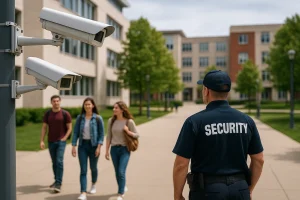Augmented Security Guards
Imagine a future where security guards are no longer limited to their physical presence, where their abilities are enhanced by cutting-edge technology. As the security landscape evolves, so do the roles of security personnel. The rise of augmented guards is transforming the way we think about security, revolutionizing the industry with their unique capabilities. Join […]
By Michael Y. Daniels
July 26, 2023

Imagine a future where security guards are no longer limited to their physical presence, where their abilities are enhanced by cutting-edge technology. As the security landscape evolves, so do the roles of security personnel. The rise of augmented guards is transforming the way we think about security, revolutionizing the industry with their unique capabilities.
Join us on this journey as we uncover the potential of augmented guards to transform the security industry, providing businesses with unparalleled protection in the face of evolving threats. Discover how this innovative approach is shaping the future of security and empowering organizations to stay one step ahead. Prepare to witness the evolution of security guards from human to hybrid, where the fusion of human capabilities and advanced technology creates a force to be reckoned with.
Augmented Guards
Traditional security models are facing unprecedented challenges. To address these challenges, a new and innovative solution has emerged: augmented guards. Augmented guards combine the strengths of human security personnel with cutting-edge technology to provide a more robust and effective security system. This fusion of human and technological capabilities has the potential to revolutionize the security industry.
Augmented guards are equipped with advanced threat intelligence systems that enable them to proactively identify and respond to potential threats. By leveraging state-of-the-art technologies, such as networked cameras, environmental sensors, and access control systems, augmented guards have enhanced situational awareness and can quickly and effectively detect and mitigate security breaches.
Unlike traditional security models that solely rely on human intervention, augmented guards provide an additional layer of protection. They work hand-in-hand with human security personnel, complementing their skills and augmenting their capabilities. This collaboration between humans and technology ensures a more comprehensive and efficient security approach.
The significance of augmented guards lies in their ability to bridge the gap between physical security and technological advancements. By leveraging the latest developments in security solutions, augmented guards can effectively address the unique challenges of the modern world. They enable businesses and organizations to stay one step ahead of potential threats and enhance their overall security posture.
Augmented Models
Augmented security represents a paradigm shift in the traditional security model. By integrating advanced technologies and intelligent systems, augmented security offers numerous benefits over conventional approaches.
- Enhanced Efficiency: Augmented security systems leverage automation and AI to streamline security operations, reducing response times and minimizing human errors.
- Proactive Defense: Unlike reactive security measures, augmented security focuses on proactive defense By harnessing advanced threat intelligence, these systems can identify potential risks and take preemptive action.
- Scalability and Adaptability: Augmented security models can easily adapt to changing security needs and They allow for flexible scalability, ensuring optimal security coverage for any setting.
- Cost-Effectiveness: Augmented security systems offer cost-saving benefits by reducing the need for extensive human resources. They complement human security personnel, maximizing their effectiveness without replacing them entirely.
The evolution towards augmented security models marks a significant step forward in the security industry. By combining human expertise with advanced technologies, these systems enhance security outcomes and enable organizations to tackle modern challenges effectively.
Replacing! NO!
Augmented guards have emerged as a powerful solution that complements the role of human security personnel without fully replacing them. These advanced systems integrate cutting-edge technology to enhance traditional security models and address the unique challenges faced by the industry today.
By incorporating augmented guards into existing security frameworks, organizations can leverage their capabilities to improve efficiency, effectiveness, and coverage. These systems work in tandem with human security personnel, extending their capabilities and providing them with valuable support.
One of the key advantages of augmented guards is their ability to handle routine tasks, such as monitoring and surveillance, allowing human security personnel to focus on more complex and critical situations. Augmented guards can efficiently cover large areas, monitor multiple camera feeds simultaneously, and analyze data in real-time, which helps identify potential threats quicker and more accurately.
The integration of augmented guards also provides a cost-effective solution for organizations, reducing the need for a large workforce and promoting operational efficiency. By automating routine tasks, businesses can allocate their human resources to more strategic and high-value activities.
However, it is essential to highlight that augmented guards do not replace the role of human security personnel entirely. They are designed to work in collaboration, combining the strengths of human judgment and experience with the speed, accuracy, and scalability provided by technology. The expertise and decision-making abilities of human security personnel remain crucial in challenging situations that require critical thinking and adaptability.
Significant Shift
With the emergence of augmented guards, the paradigm of threat intelligence in the security industry is undergoing a significant shift. These advanced systems leverage cutting-edge technologies to contribute to proactive defense strategies. Augmented guards are equipped with sophisticated threat intelligence capabilities, allowing them to analyze and identify potential threats in real-time.
By leveraging advanced analytics and machine learning algorithms, augmented guards can detect patterns, anomalies, and emerging risks that may go unnoticed by traditional security models. This enables security personnel to take swift and effective action, preventing incidents before they escalate.
The integration of augmented guards with threat intelligence not only enhances the overall security posture but also enables a more proactive approach to defense. Stay ahead of evolving threats and safeguard your premises with the power of augmented guards.
Effective Security Management
Augmented guards are not only reshaping the security industry but also revolutionizing the way security management is approached. In the 7th edition of “Effective Security Management,” we explore the profound connection between augmented guards and effective security practices.
-
Integrating Advanced Technologies:
Augmented guards utilize cutting-edge technologies such as artificial intelligence, machine learning, and video analytics. These tools enable enhanced threat detection, real-time monitoring, and actionable insights for security teams.
-
Proactive Threat Prevention:
Augmented guards contribute to proactive security management by leveraging advanced threat intelligence. With their ability to analyze data, detect patterns, and identify potential risks, they empower security teams to take preventive measures before incidents occur.
-
Streamlined Operations:
By automating routine tasks, augmented guards optimize resource allocation and improve operational efficiency. This allows security managers to focus on strategic decision-making and critical security concerns.
-
Enhanced Situational Awareness:
Augmented guards provide real-time situational awareness through an interconnected system of cameras, sensors, and analytics. This comprehensive view enables security managers to respond promptly and effectively to any security threats or incidents.
Securing the Hybrid Workforce
In today’s rapidly evolving work environment, characterized by a blend of remote and onsite employees, ensuring the security of the hybrid workforce has become paramount. Swift action is crucial to maintain a safe and secure work environment. Here are key reasons why proactive security measures are essential:
- Adapting to New Threats: The hybrid workforce presents unique security challenges, with
employees accessing sensitive data from various devices and locations. Swift action allows organizations to address emerging threats effectively.
- Preventing Data Breaches: Proactive security measures minimize the risk of data breaches, ensuring that sensitive information remains Swift actions, such as implementing robust access control systems and monitoring network activity, can swiftly detect and prevent potential breaches.
- Mitigating Physical Risks: Swift response measures are vital to safeguard employees from physical risks in both remote and onsite Timely incident reporting, emergency response plans, and employee safety training contribute to enhanced security.
- Maintaining Productivity: Swiftly addressing security concerns helps maintain business continuity and employee By promptly handling security incidents, organizations can minimize downtime and ensure a seamless workflow.
Remember, in the hybrid workforce, a proactive security approach is essential to protect both digital and physical assets. Swift action not only mitigates risks but also instills confidence in the workforce, fostering a secure and resilient work environment.
Stay in the Know
Staying informed about the latest trends in enterprise risk and security is crucial for those seeking to enhance their knowledge and stay ahead in today’s rapidly evolving world. By staying up-to-date with industry developments, professionals can better understand the emerging risks, technologies, and practices that shape the security landscape. They can gain insights into innovative approaches, such as augmented guards and enhanced threat intelligence, that are revolutionizing the field.
Whether it’s understanding the impact of hybrid work models on security or keeping abreast of new regulations, regularly following updates in enterprise risk and security ensures professionals are equipped with the knowledge they need to protect organizations from threats.
Related Posts
Business Growth
Uncover crucial insights for CEOs and business owners to develop and control a top-level security firm. Grasp necessary advice for impactful leadership, cutting-edge security methods, and upholding top-notch industry benchmarks to make your firm stand apart in the competitive security field.
By Richelle Mayor
November 24, 2023
Security Guards
What are the Key Components of a Security Guard Dress Code? The key components of a security guard dress code must include clear, distinctive uniforms that identify their role and meet company and state requirements. This includes badges, patches, and carrying necessary permits. Essential gear, like high-visibility or protective clothing, is also part of the […]
By Catherine Shannon
January 3, 2025
Business Growth
Technological progress has profoundly transformed the realm of surveillance equipment, delivering unparalleled functionalities for safety and supervision in this digital era. Integrating artificial intelligence (AI) and improving image recognition has not only boosted surveillance efficiency but also sparked crucial debates concerning privacy and ethical implications.
By Richelle Mayor
November 29, 2023





